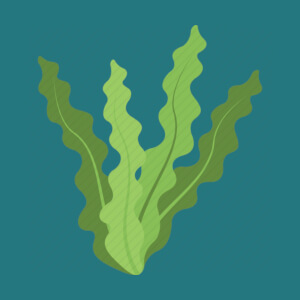


Algae is the common, or non-scientific, name given to a group of thousands of different saltwater and freshwater organisms that use photosynthesis to make energy from sunlight. While they share a lot of similarities with plants, algae do not have roots, stems, or leaves.
Some algae, like diatoms and dinoflagellates, are single-celled and so small that they can only be seen under a microscope. Other species of algae, like kelp, can grow to be more than 45 m long, growing together in thick underwater forests.
While algae may seem simple, different species play a major role in water ecosystems. Algae form the base layer of many food webs and chains, and are a huge source of oxygen production through photosynthesis.
In addition to their importance to the environment, algae have many practical uses for humans. For example, they are used to produce food, fuel, and even medicine. Some species of algae are rich in protein and are used as a source of food for both humans and animals. Algae are also used in the production of biofuels, which can help reduce our dependence on fossil fuels.
Spirulina, a type of blue-green algae, has been used as a food source for centuries in certain cultures, but it is also a rich source of natural pigments. Its blue-green color comes from a pigment called phycocyanin, which also offers several health benefits to people who eat it.
Another type of algae used for pigments is Porphyra, or nori. This red algae is commonly used in Japanese cuisine as a wrap for sushi, but it also contains pigments that can be extracted for use as natural dyes. The pigment responsible for its red color is called phycoerythrin, which is a protein that absorbs green light and reflects red light.
Nostoc is another type of blue-green algae that has been traditionally used by indigenous communities in North America for food and medicine. It contains a pigment called nostocarubin, which gives it a reddish-brown color.
Scientists call this bioluminescence, or the ability of living things to create their own light. The main group of bioluminescent algae are known as dinoflagellates, microscopic single-celled organisms that have tails to help them move through the water. When the water they live in is disturbed, they create a beautiful blue-green light show that looks like something out of a fairy tale.
Scientists have even studied these glowing algae to see if they could be used to help us in the future. For example, they could be used to help doctors see inside the human body during medical procedures, or to detect pollution in the ocean.
Agar is a gelatin-like substance made from seaweed that has both scientific and culinary use. In science labs, agar is used to provide a solid surface for the microorganisms to grow and reproduce, enabling scientists to study their properties and behavior. Agar is also used in medical applications, such as creating gel capsules for medication.
In cooking, agar is commonly used as a vegetarian substitute for gelatin in desserts and candies, such as gummy bears and fruit snacks. Agar can also be used to create a type of Japanese dessert called agar-agar, which is a sweet, jelly-like dish. Agar is also even used in the production of certain types of cheese and as a thickener for soups and sauces.
The fossil record provides strong evidence that all land plants evolved from a group of green algae, which is estimated to have occurred about 1 billion years ago. The earliest fossilized land plants were simple non-vascular plants, such as liverworts and mosses, that appeared around 470 million years ago. Over time, more complex vascular plants like ferns and seed plants evolved, and eventually led to the diverse plant life that we see around us. Today, the closest living relatives of land plants are a group of freshwater algae called Charophyta.
There are a number of types of algae that are commonly consumed by humans, either whole or as additives to other foods. One of the most well-known is nori, which is a type of red algae that is commonly used to wrap sushi rolls. Other types of red algae, such as dulse and laver, are also sometimes eaten as snacks or added to soups and stews for their flavor and nutritional content.
Green algae, such as chlorella and spirulina, are also consumed by humans as dietary supplements due to their high protein content and other nutrients. These algae can be found in tablet or powder form and added to smoothies or other foods.
In addition to their nutritional value, some types of algae are also used in the production of food additives, such as carrageenan, which is derived from red algae and used as a thickener in many dairy and non-dairy products. Agar, which is derived from red algae, is also used as a thickener and gelling agent in a wide range of food products, including desserts, jellies, and candy.
Algae is the primary source of food for most fish and other aquatic life. Additionally, because all land plants evolved from algae, there would be no life and land without it. And if all this wasn't already enough, scientists also estimate that algae produce up to 80% of Earth's oxygen.